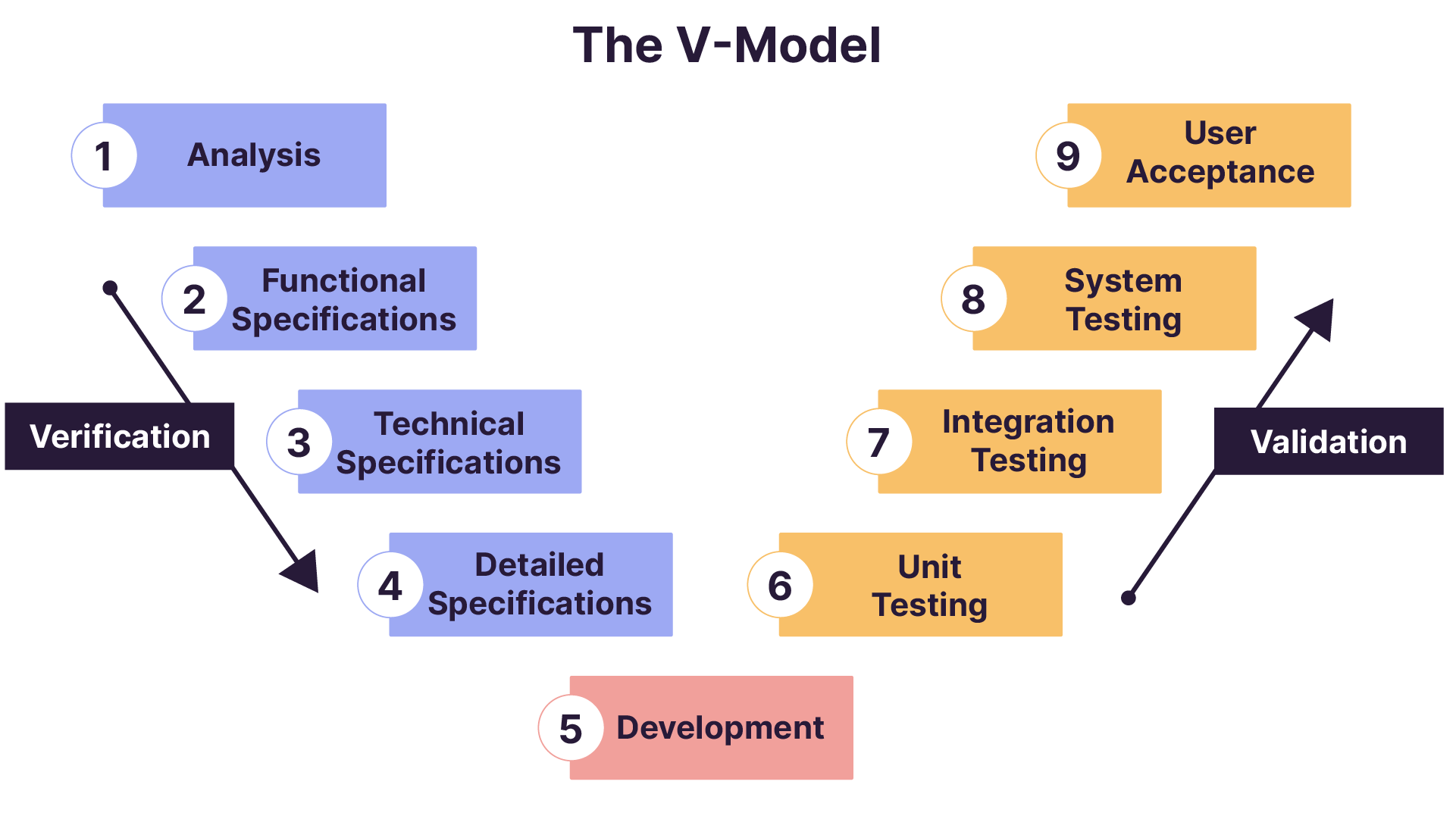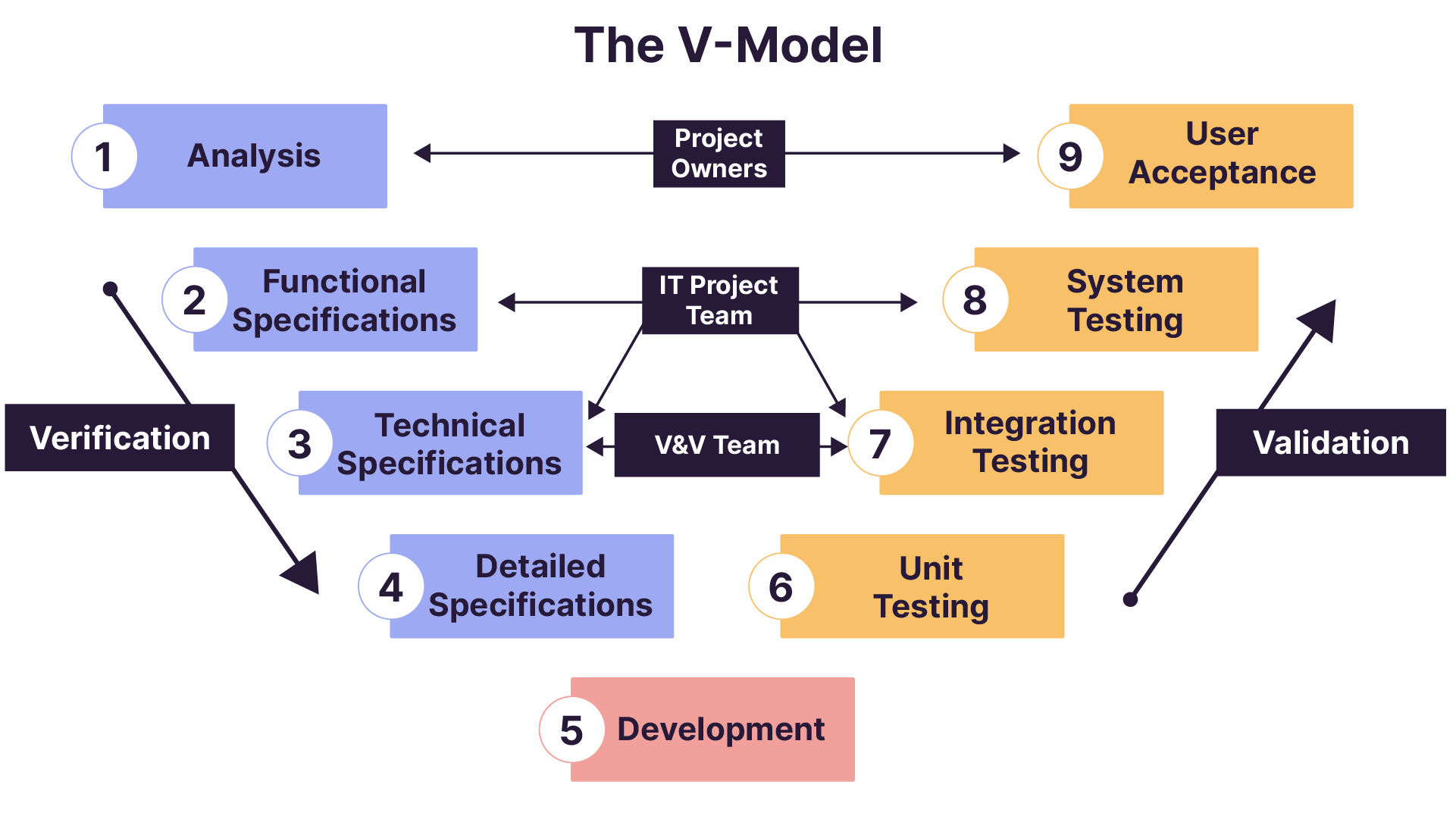Understand the Steps in the V-Model
In software development, the V-model is a highly effective project management methodology used to create what we call “critical” applications. Its key advantage lies in the rigorous approach used to ensure that an application is high quality and fit for purpose.
“A critical application?” What does that mean?
A critical application is a piece of software or a computer program that is extremely important and therefore must function correctly when performing vital or sensitive tasks.
These applications are often used where human life, infrastructure, or sensitive data are at stake. This could include the aerospace, medicine, finance, or military sectors. The software must perform flawlessly, because any defects could have a significant impact. Imagine an airplane falling out of the sky because there was a bug in the instrument panel!
What do I need to know about the V-model?
First of all, you need to understand how this methodology works.
To do this, you’ll need to fully comprehend the V-model pillars, understand the logical sequence between project phases, and learn the requirements for each phase.
The Pillars
The V-model is based on two pillars: verification and validation. The reason we call it verification is because the initial phase involves verifying that the specifications will correctly meet the requirements defined for the project. The second part is known as validation because this is when we use testing to validate the quality of the product and whether it meets the defined specifications.
The Approach
One way to describe the V-model approach is to imagine that the first part of the V, the downward sloping section ↘️, is the part that describes the project requirements, starting from some general descriptions. As we progress down the slope, the descriptions become more specific, so the developers who will be coding the application will have as much detail as possible.
The approach is different in the second part of the V, the upward sloping section ↗️. Once the application is created by the developers, it will be subject to a detailed validation process to test the quality of the code. As we progress up this slope, the testing will become broader in scope so that the testers can validate how the application works as a whole.
The Nine Steps
Let’s Talk About the Steps in the V-Model Process

Everything starts with analysis, which is the first step. This is the stage when the client communicates their requirements and constraints to the team, who will analyze their request with a view to defining the solution.
Next, we have step 2, the functional specifications. This is the time when the team comes up with its initial proposals for the application functionality and the project plan without going into too much detail.
During step 3, the team handles the technical aspects of the project, focusing on “how” the application will be developed (software, hardware, methods, processes, etc.). These are known as the technical specifications.
Next, we have step 4, which involves describing the project functionality to a much greater level of detail. For example, this can include database schemas. The developers will then have all the details they need to create accurate, high-quality code. These are known as the detailed specifications or the detailed design.
After these four steps in the V-model process, the specifications can be approved by the client, and the application can then be coded by the developers. Step 5 is known as programming or development.
After step 5, the V-model will focus on testing to check the quality of the software before it’s delivered.
Testing is carried out at a number of levels:
Let’s start with unit testing, which happens during step 6. During this step, the developers check that sections of code that carry out specific actions are working correctly. These sections of code are more commonly known as “components.”
Once the unit testing has been successfully completed, testers then carry out integration testing in step 7. This step involves checking if the sections of code, known as components, work correctly once they’re linked together.
If the integration testing is successful, we move to step 8, where we test the overall functionality of the application. This is known as system testing.
We complete the process with step 9, which involves deploying the system so that it is ready for use. This means implementing it to the production environment together with its documentation, after some final checks and client approval. The client will have also completed their own tests. This is what we call user acceptance and deployment.
Identify the Stakeholders Within the V-Model

Within the V-model, there are several groups of stakeholders who play a key role in the project. I suggest that we group them into three categories.
The Project Owners: The project owners are responsible for defining the project requirements and objectives. They represent the interests of the client or end user, and their role is to determine the product or system that must be delivered.
The IT Project Team: The IT project team is responsible for the product design and development. They work in close collaboration with the project owners to understand their requirements and develop the product based on these needs. They will ensure that the solution is technically feasible.
The V&V (Verification and Validation) Team: This team is focused on product quality assurance. Its role is to check that the product meets the defined requirements, which is known as verification, and also that the product meets the needs and expectations of the end user, which is known as validation.
To summarize, the project owners define what the product must do, the IT project team builds the product, and the V&V team ensures that the product works as expected.
Over to You!

Background
AirGalaxy is a company whose aim is to create an application that will monitor the state of rockets before they are launched into space. This application is critical in ensuring that space flights are safe.
AirGalaxy has adopted the V-model approach to plan the functionality, the technical aspects, and the tests required to ensure a high-quality application.
Instructions
Assign each task to one of the three key teams: Project owners, IT project team, or V&V team. In Notion, you’ll find a list of 7 tasks to complete using the RACI method :
To be effective, you must allocate roles and responsibilities for each of the process activities. It's not always easy to know who does what. This is where RACI comes into play. It's a matrix, a table that helps establish roles and responsibilities. The roles are defined by each of the letters:
Responsible: these are the individuals who carry out the activity of the procedure.
Accountable: this is the authority, the person who is answerable for the activity. There should be only one person for a given activity.
Consulted: individuals whose advice and opinions are valuable.
Informed: individuals who need to be kept informed about the progress of activities.
Your task, here, is to select the appropriate team label for each activity.
Analyze the Qualities of a Project Manager
A team working with the V-model methodology needs project managers. These are people who are skilled in planning, communicating, and tracking progress on a project so that all team members work together efficiently to achieve the final objective.
Within the V-model approach, there might be a number of project managers, either among the project owners, in the IT project team, or the V&V team. They still need the same skills, even if the focus of each group is different. Let’s explore the hard and soft skills we expect from a project manager.
In terms of hard skills, the project manager can:
apply project management techniques.
plan the different steps in the V-model.
write succinct overviews.
In terms of soft skills, the project manager has:
excellent communication skills.
effective leadership skills, including confidence and active listening.
strong digital literacy skills.
the ability to manage stress and conflicts.
Prepare Your Value Proposition
When you kick off a project using the V-model methodology, your role as project manager is to contribute to three key documents.
These are the business requirements document, the functional specifications, and the technical specifications.
These documents are written at specific stages during the V-model process, as detailed below:
Business Requirements
Created during the first step in the V-model process by the project owners, this is the first project reference document. It enables the project owners to detail the project requirements, expectations, and objectives, which you’ll distribute to the team that will be developing the solution. If you’re a project manager within the team of project owners, you’ll contribute to writing and distributing this document.
Functional Specifications
Created during the second step in the V-model process by the IT project team, this document details the proposed functionality for the application. The document will describe the actions that the application will perform, which need to adhere to the expectations set out in the business requirements document.
If you’re a project manager within the IT project team, you’ll contribute to writing and distributing this document. If you’re a project owner, you’ll contribute to signing off on or rejecting these specifications.
Technical and Detailed Specifications
Created during phases three and four of the V-model process by the IT project team, this document is sometimes split into two parts.
The technical specifications describe all of the technical elements needed to deliver the application, while the detailed specifications provide a more in-depth description of the application features.
These two documents must adhere to the functional specifications, which will have been previously signed off on by the project owners during step 2.
If you’re a project manager within the IT project team, you’ll contribute to writing and distributing these documents. If you’re a project owner, you’ll contribute to signing off on or rejecting these specifications.
As you can tell, the business requirements and the various specification documents are tightly linked. There must be a process of verification and validation at each stage to ensure there are no gaps or errors in these documents.
This set of documents represents a value proposition, because it enables the project owners and IT project team to confirm the details of the project functionality that needs to be developed.
Let’s Recap
The V-model is a project management methodology designed to deliver high-quality, critical applications following nine verification and validation steps.
Critical applications are key software systems used in high-stakes settings, such as medicine or aviation.
The project manager has strong technical and people skills and plays a pivotal role throughout the project by coordinating activities between the project owners and the IT project team.
The creation of the value proposition, consisting of business requirements and specifications, acts as a guide for the project and meets the needs of the client.
Are you ready to formalize the client’s requirements? Well, join us on the next stage. Ensure that your project succeeds by defining your client’s requirements in your ultimate guide: the business requirements document!
